Open Disclosure in Clinical Misadventure
VerifiedAdded on 2023/06/07
|13
|3619
|347
AI Summary
This article discusses the importance of open disclosure in clinical misadventure and its legal and ethical principles. It covers the elements of an open disclosure, the rights and responsibilities of clinicians, and the role of managers in the process.
Contribute Materials
Your contribution can guide someone’s learning journey. Share your
documents today.
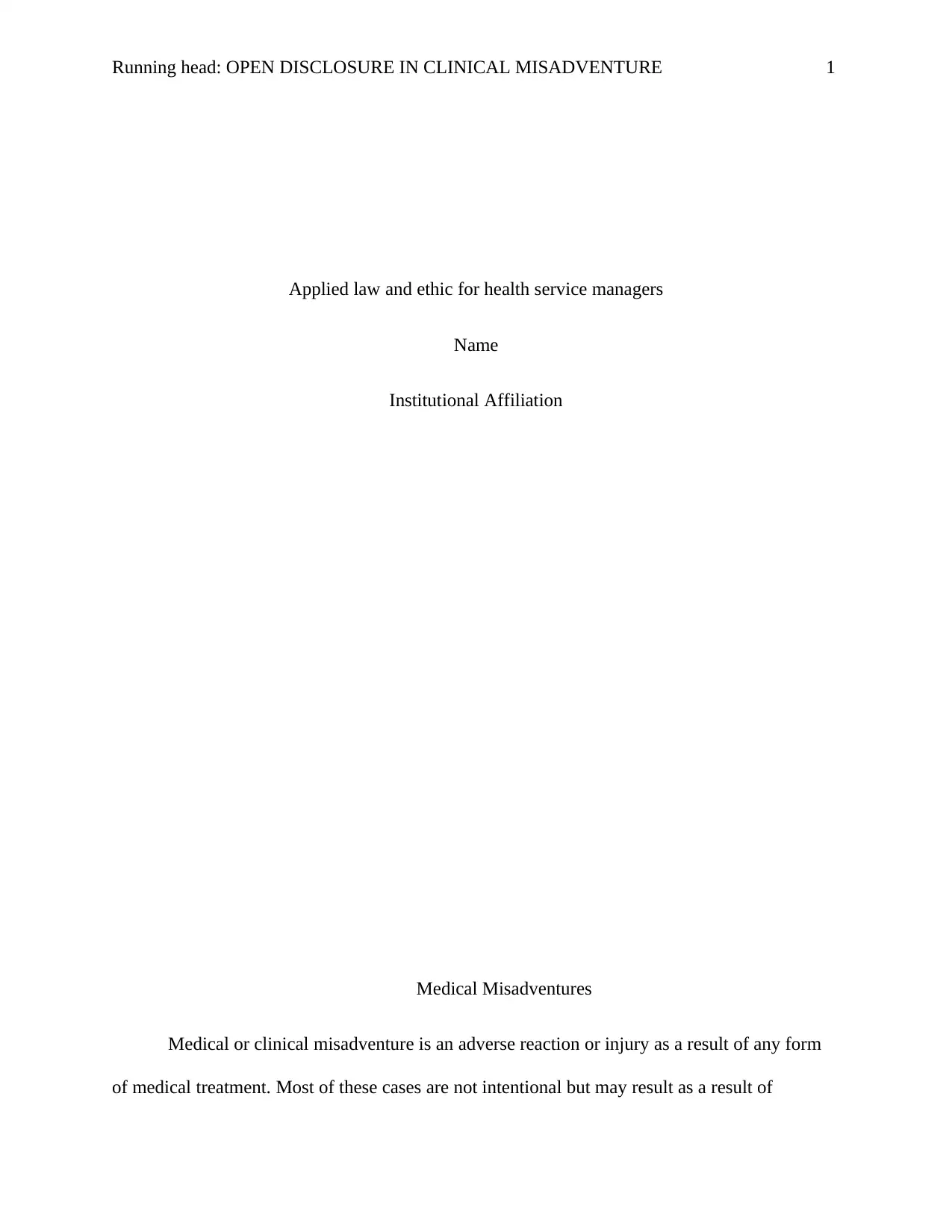
Running head: OPEN DISCLOSURE IN CLINICAL MISADVENTURE 1
Applied law and ethic for health service managers
Name
Institutional Affiliation
Medical Misadventures
Medical or clinical misadventure is an adverse reaction or injury as a result of any form
of medical treatment. Most of these cases are not intentional but may result as a result of
Applied law and ethic for health service managers
Name
Institutional Affiliation
Medical Misadventures
Medical or clinical misadventure is an adverse reaction or injury as a result of any form
of medical treatment. Most of these cases are not intentional but may result as a result of
Secure Best Marks with AI Grader
Need help grading? Try our AI Grader for instant feedback on your assignments.
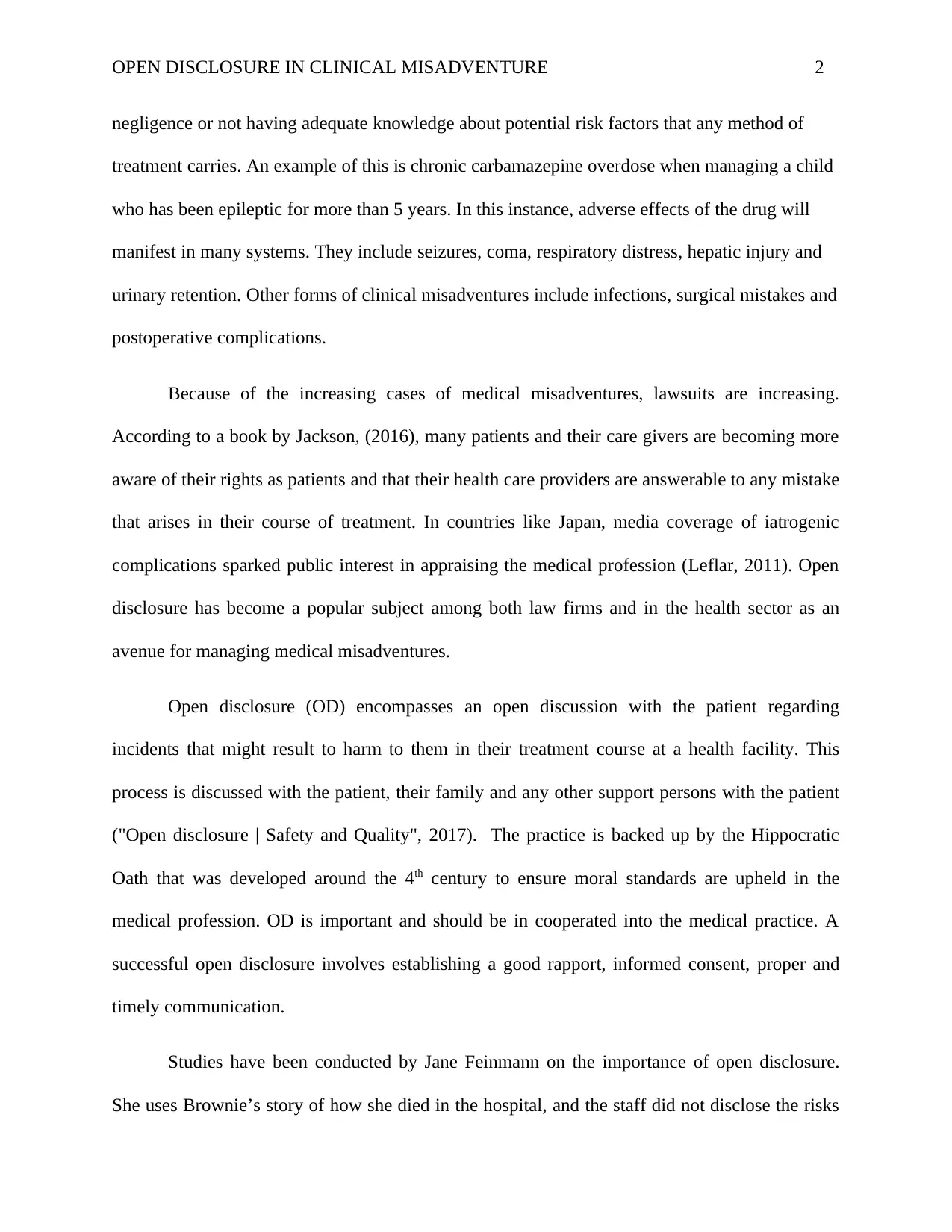
OPEN DISCLOSURE IN CLINICAL MISADVENTURE 2
negligence or not having adequate knowledge about potential risk factors that any method of
treatment carries. An example of this is chronic carbamazepine overdose when managing a child
who has been epileptic for more than 5 years. In this instance, adverse effects of the drug will
manifest in many systems. They include seizures, coma, respiratory distress, hepatic injury and
urinary retention. Other forms of clinical misadventures include infections, surgical mistakes and
postoperative complications.
Because of the increasing cases of medical misadventures, lawsuits are increasing.
According to a book by Jackson, (2016), many patients and their care givers are becoming more
aware of their rights as patients and that their health care providers are answerable to any mistake
that arises in their course of treatment. In countries like Japan, media coverage of iatrogenic
complications sparked public interest in appraising the medical profession (Leflar, 2011). Open
disclosure has become a popular subject among both law firms and in the health sector as an
avenue for managing medical misadventures.
Open disclosure (OD) encompasses an open discussion with the patient regarding
incidents that might result to harm to them in their treatment course at a health facility. This
process is discussed with the patient, their family and any other support persons with the patient
("Open disclosure | Safety and Quality", 2017). The practice is backed up by the Hippocratic
Oath that was developed around the 4th century to ensure moral standards are upheld in the
medical profession. OD is important and should be in cooperated into the medical practice. A
successful open disclosure involves establishing a good rapport, informed consent, proper and
timely communication.
Studies have been conducted by Jane Feinmann on the importance of open disclosure.
She uses Brownie’s story of how she died in the hospital, and the staff did not disclose the risks
negligence or not having adequate knowledge about potential risk factors that any method of
treatment carries. An example of this is chronic carbamazepine overdose when managing a child
who has been epileptic for more than 5 years. In this instance, adverse effects of the drug will
manifest in many systems. They include seizures, coma, respiratory distress, hepatic injury and
urinary retention. Other forms of clinical misadventures include infections, surgical mistakes and
postoperative complications.
Because of the increasing cases of medical misadventures, lawsuits are increasing.
According to a book by Jackson, (2016), many patients and their care givers are becoming more
aware of their rights as patients and that their health care providers are answerable to any mistake
that arises in their course of treatment. In countries like Japan, media coverage of iatrogenic
complications sparked public interest in appraising the medical profession (Leflar, 2011). Open
disclosure has become a popular subject among both law firms and in the health sector as an
avenue for managing medical misadventures.
Open disclosure (OD) encompasses an open discussion with the patient regarding
incidents that might result to harm to them in their treatment course at a health facility. This
process is discussed with the patient, their family and any other support persons with the patient
("Open disclosure | Safety and Quality", 2017). The practice is backed up by the Hippocratic
Oath that was developed around the 4th century to ensure moral standards are upheld in the
medical profession. OD is important and should be in cooperated into the medical practice. A
successful open disclosure involves establishing a good rapport, informed consent, proper and
timely communication.
Studies have been conducted by Jane Feinmann on the importance of open disclosure.
She uses Brownie’s story of how she died in the hospital, and the staff did not disclose the risks
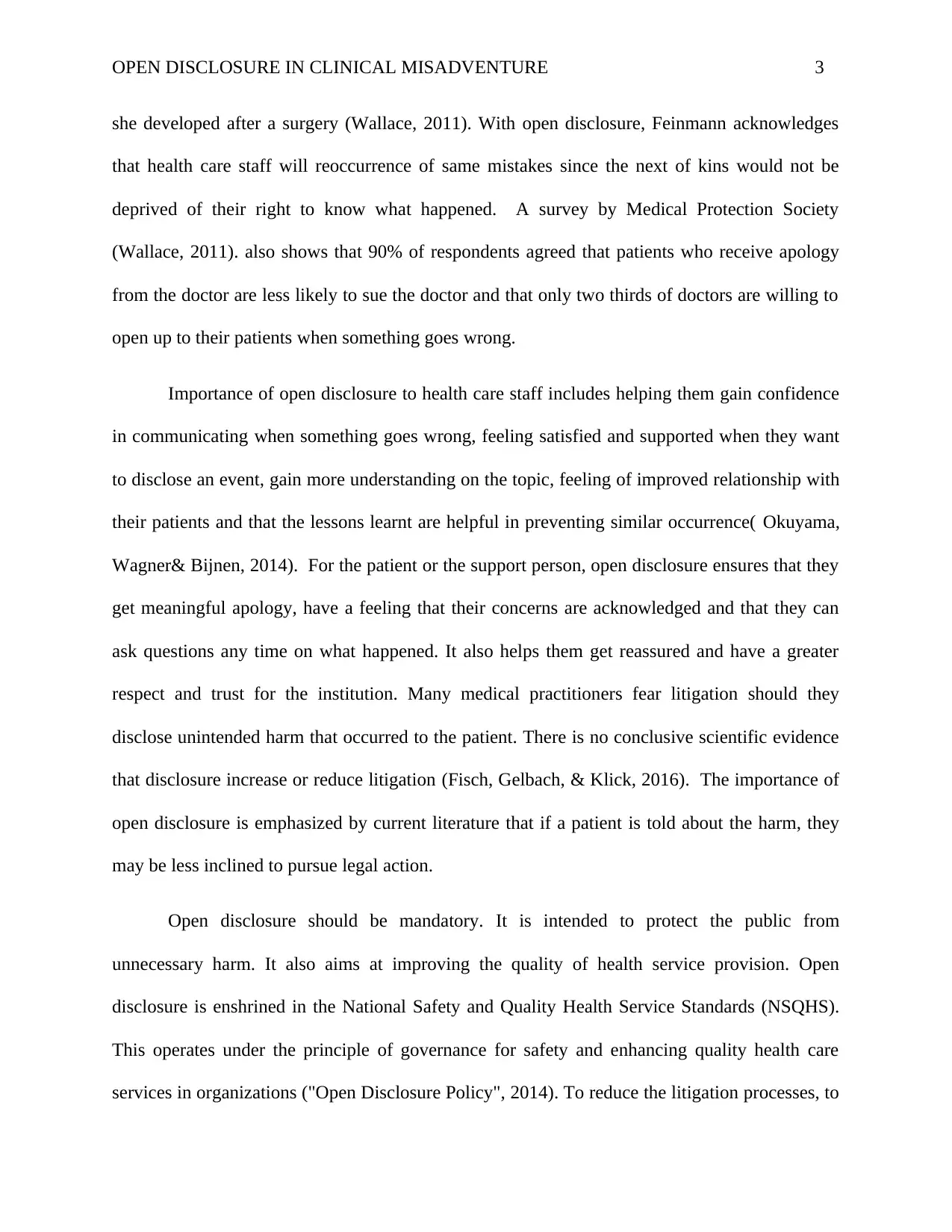
OPEN DISCLOSURE IN CLINICAL MISADVENTURE 3
she developed after a surgery (Wallace, 2011). With open disclosure, Feinmann acknowledges
that health care staff will reoccurrence of same mistakes since the next of kins would not be
deprived of their right to know what happened. A survey by Medical Protection Society
(Wallace, 2011). also shows that 90% of respondents agreed that patients who receive apology
from the doctor are less likely to sue the doctor and that only two thirds of doctors are willing to
open up to their patients when something goes wrong.
Importance of open disclosure to health care staff includes helping them gain confidence
in communicating when something goes wrong, feeling satisfied and supported when they want
to disclose an event, gain more understanding on the topic, feeling of improved relationship with
their patients and that the lessons learnt are helpful in preventing similar occurrence( Okuyama,
Wagner& Bijnen, 2014). For the patient or the support person, open disclosure ensures that they
get meaningful apology, have a feeling that their concerns are acknowledged and that they can
ask questions any time on what happened. It also helps them get reassured and have a greater
respect and trust for the institution. Many medical practitioners fear litigation should they
disclose unintended harm that occurred to the patient. There is no conclusive scientific evidence
that disclosure increase or reduce litigation (Fisch, Gelbach, & Klick, 2016). The importance of
open disclosure is emphasized by current literature that if a patient is told about the harm, they
may be less inclined to pursue legal action.
Open disclosure should be mandatory. It is intended to protect the public from
unnecessary harm. It also aims at improving the quality of health service provision. Open
disclosure is enshrined in the National Safety and Quality Health Service Standards (NSQHS).
This operates under the principle of governance for safety and enhancing quality health care
services in organizations ("Open Disclosure Policy", 2014). To reduce the litigation processes, to
she developed after a surgery (Wallace, 2011). With open disclosure, Feinmann acknowledges
that health care staff will reoccurrence of same mistakes since the next of kins would not be
deprived of their right to know what happened. A survey by Medical Protection Society
(Wallace, 2011). also shows that 90% of respondents agreed that patients who receive apology
from the doctor are less likely to sue the doctor and that only two thirds of doctors are willing to
open up to their patients when something goes wrong.
Importance of open disclosure to health care staff includes helping them gain confidence
in communicating when something goes wrong, feeling satisfied and supported when they want
to disclose an event, gain more understanding on the topic, feeling of improved relationship with
their patients and that the lessons learnt are helpful in preventing similar occurrence( Okuyama,
Wagner& Bijnen, 2014). For the patient or the support person, open disclosure ensures that they
get meaningful apology, have a feeling that their concerns are acknowledged and that they can
ask questions any time on what happened. It also helps them get reassured and have a greater
respect and trust for the institution. Many medical practitioners fear litigation should they
disclose unintended harm that occurred to the patient. There is no conclusive scientific evidence
that disclosure increase or reduce litigation (Fisch, Gelbach, & Klick, 2016). The importance of
open disclosure is emphasized by current literature that if a patient is told about the harm, they
may be less inclined to pursue legal action.
Open disclosure should be mandatory. It is intended to protect the public from
unnecessary harm. It also aims at improving the quality of health service provision. Open
disclosure is enshrined in the National Safety and Quality Health Service Standards (NSQHS).
This operates under the principle of governance for safety and enhancing quality health care
services in organizations ("Open Disclosure Policy", 2014). To reduce the litigation processes, to

OPEN DISCLOSURE IN CLINICAL MISADVENTURE 4
protect the institution’s image, to ensure that patient safety is upheld and medical legal issues are
taken into account, the process of open disclosure should be mandatory.
Open disclosure process involves honesty, empathy and timely discussions between the
health care provider and the patient after an incident. When done effectively, it ensures more
confidence and trust in the health facility by the community, Koller et al., (2016). Before
initiating the process, one must ensure that there is a trained expertise for the job, all staff must
be aware of the commitment the organization has to disclose information and timely information
should be provided to the staff participating in the process. The process, as shown by the
Australian open disclosure framework includes a framework of eight guiding principles. They
are:
Open and timely communication after the incident.
Acknowledging that the event occurred.
Apologizing to the patient or the caregiver or expressing regrets.
Supporting and meeting the expectations and needs of the patient, family and
caregivers.
Supporting and meeting the needs of those providing care in the facility.
Good governance.
Confidentiality in one’s self.
In summary, the elements of an open disclosure include apology, acknowledgement of
compromised patient safety, active listening and responding to patient and their support person,
discussing the consequences of the incident, proving room for patient and their support persons
to ask questions, explaining the steps taken in managing the incident and proving support for the
protect the institution’s image, to ensure that patient safety is upheld and medical legal issues are
taken into account, the process of open disclosure should be mandatory.
Open disclosure process involves honesty, empathy and timely discussions between the
health care provider and the patient after an incident. When done effectively, it ensures more
confidence and trust in the health facility by the community, Koller et al., (2016). Before
initiating the process, one must ensure that there is a trained expertise for the job, all staff must
be aware of the commitment the organization has to disclose information and timely information
should be provided to the staff participating in the process. The process, as shown by the
Australian open disclosure framework includes a framework of eight guiding principles. They
are:
Open and timely communication after the incident.
Acknowledging that the event occurred.
Apologizing to the patient or the caregiver or expressing regrets.
Supporting and meeting the expectations and needs of the patient, family and
caregivers.
Supporting and meeting the needs of those providing care in the facility.
Good governance.
Confidentiality in one’s self.
In summary, the elements of an open disclosure include apology, acknowledgement of
compromised patient safety, active listening and responding to patient and their support person,
discussing the consequences of the incident, proving room for patient and their support persons
to ask questions, explaining the steps taken in managing the incident and proving support for the
Secure Best Marks with AI Grader
Need help grading? Try our AI Grader for instant feedback on your assignments.
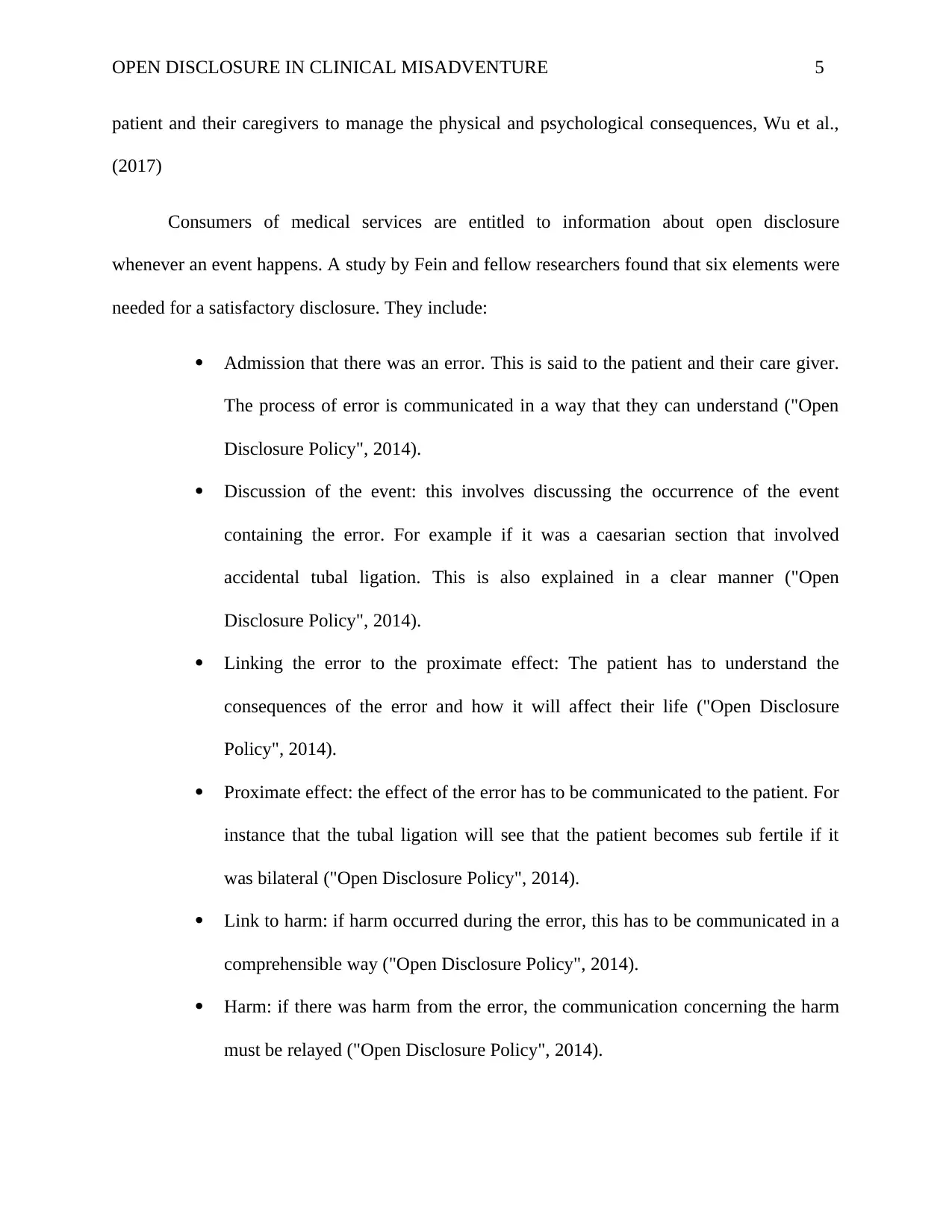
OPEN DISCLOSURE IN CLINICAL MISADVENTURE 5
patient and their caregivers to manage the physical and psychological consequences, Wu et al.,
(2017)
Consumers of medical services are entitled to information about open disclosure
whenever an event happens. A study by Fein and fellow researchers found that six elements were
needed for a satisfactory disclosure. They include:
Admission that there was an error. This is said to the patient and their care giver.
The process of error is communicated in a way that they can understand ("Open
Disclosure Policy", 2014).
Discussion of the event: this involves discussing the occurrence of the event
containing the error. For example if it was a caesarian section that involved
accidental tubal ligation. This is also explained in a clear manner ("Open
Disclosure Policy", 2014).
Linking the error to the proximate effect: The patient has to understand the
consequences of the error and how it will affect their life ("Open Disclosure
Policy", 2014).
Proximate effect: the effect of the error has to be communicated to the patient. For
instance that the tubal ligation will see that the patient becomes sub fertile if it
was bilateral ("Open Disclosure Policy", 2014).
Link to harm: if harm occurred during the error, this has to be communicated in a
comprehensible way ("Open Disclosure Policy", 2014).
Harm: if there was harm from the error, the communication concerning the harm
must be relayed ("Open Disclosure Policy", 2014).
patient and their caregivers to manage the physical and psychological consequences, Wu et al.,
(2017)
Consumers of medical services are entitled to information about open disclosure
whenever an event happens. A study by Fein and fellow researchers found that six elements were
needed for a satisfactory disclosure. They include:
Admission that there was an error. This is said to the patient and their care giver.
The process of error is communicated in a way that they can understand ("Open
Disclosure Policy", 2014).
Discussion of the event: this involves discussing the occurrence of the event
containing the error. For example if it was a caesarian section that involved
accidental tubal ligation. This is also explained in a clear manner ("Open
Disclosure Policy", 2014).
Linking the error to the proximate effect: The patient has to understand the
consequences of the error and how it will affect their life ("Open Disclosure
Policy", 2014).
Proximate effect: the effect of the error has to be communicated to the patient. For
instance that the tubal ligation will see that the patient becomes sub fertile if it
was bilateral ("Open Disclosure Policy", 2014).
Link to harm: if harm occurred during the error, this has to be communicated in a
comprehensible way ("Open Disclosure Policy", 2014).
Harm: if there was harm from the error, the communication concerning the harm
must be relayed ("Open Disclosure Policy", 2014).
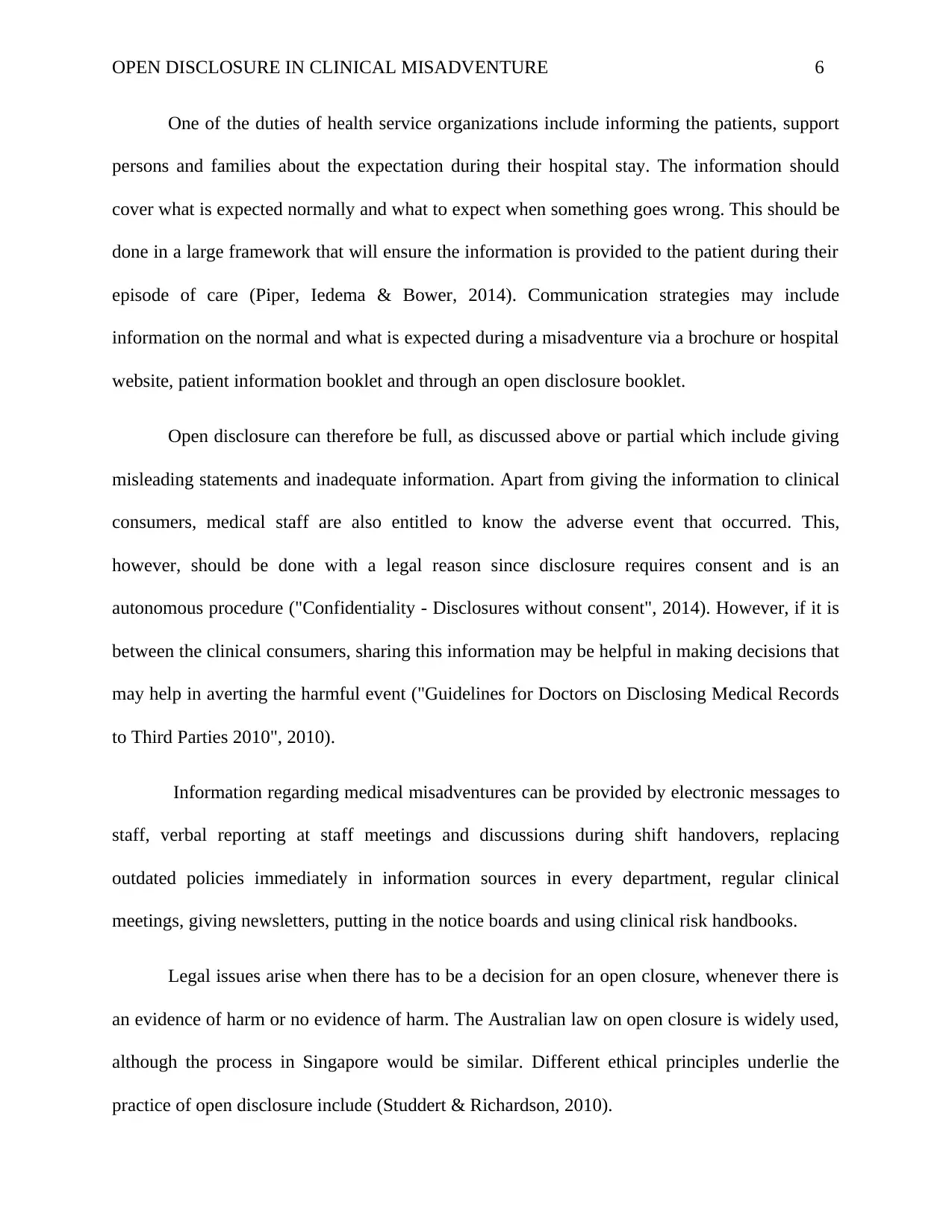
OPEN DISCLOSURE IN CLINICAL MISADVENTURE 6
One of the duties of health service organizations include informing the patients, support
persons and families about the expectation during their hospital stay. The information should
cover what is expected normally and what to expect when something goes wrong. This should be
done in a large framework that will ensure the information is provided to the patient during their
episode of care (Piper, Iedema & Bower, 2014). Communication strategies may include
information on the normal and what is expected during a misadventure via a brochure or hospital
website, patient information booklet and through an open disclosure booklet.
Open disclosure can therefore be full, as discussed above or partial which include giving
misleading statements and inadequate information. Apart from giving the information to clinical
consumers, medical staff are also entitled to know the adverse event that occurred. This,
however, should be done with a legal reason since disclosure requires consent and is an
autonomous procedure ("Confidentiality - Disclosures without consent", 2014). However, if it is
between the clinical consumers, sharing this information may be helpful in making decisions that
may help in averting the harmful event ("Guidelines for Doctors on Disclosing Medical Records
to Third Parties 2010", 2010).
Information regarding medical misadventures can be provided by electronic messages to
staff, verbal reporting at staff meetings and discussions during shift handovers, replacing
outdated policies immediately in information sources in every department, regular clinical
meetings, giving newsletters, putting in the notice boards and using clinical risk handbooks.
Legal issues arise when there has to be a decision for an open closure, whenever there is
an evidence of harm or no evidence of harm. The Australian law on open closure is widely used,
although the process in Singapore would be similar. Different ethical principles underlie the
practice of open disclosure include (Studdert & Richardson, 2010).
One of the duties of health service organizations include informing the patients, support
persons and families about the expectation during their hospital stay. The information should
cover what is expected normally and what to expect when something goes wrong. This should be
done in a large framework that will ensure the information is provided to the patient during their
episode of care (Piper, Iedema & Bower, 2014). Communication strategies may include
information on the normal and what is expected during a misadventure via a brochure or hospital
website, patient information booklet and through an open disclosure booklet.
Open disclosure can therefore be full, as discussed above or partial which include giving
misleading statements and inadequate information. Apart from giving the information to clinical
consumers, medical staff are also entitled to know the adverse event that occurred. This,
however, should be done with a legal reason since disclosure requires consent and is an
autonomous procedure ("Confidentiality - Disclosures without consent", 2014). However, if it is
between the clinical consumers, sharing this information may be helpful in making decisions that
may help in averting the harmful event ("Guidelines for Doctors on Disclosing Medical Records
to Third Parties 2010", 2010).
Information regarding medical misadventures can be provided by electronic messages to
staff, verbal reporting at staff meetings and discussions during shift handovers, replacing
outdated policies immediately in information sources in every department, regular clinical
meetings, giving newsletters, putting in the notice boards and using clinical risk handbooks.
Legal issues arise when there has to be a decision for an open closure, whenever there is
an evidence of harm or no evidence of harm. The Australian law on open closure is widely used,
although the process in Singapore would be similar. Different ethical principles underlie the
practice of open disclosure include (Studdert & Richardson, 2010).

OPEN DISCLOSURE IN CLINICAL MISADVENTURE 7
1. Privacy between what the patient and clinician discuss during the process (Studdert &
Richardson, 2010).
2. Confidentiality to ensure that the information gets to only those who want to know
(Studdert & Richardson, 2010)..
3. Veracity which includes truth, informed consent and autonomy in the clinician patient
relationship (Studdert & Richardson, 2010)..
4. Fidelity involving loyalty (Studdert & Richardson, 2010).
In evidence of harm, open disclosure is mandatory. In a relationship perspective, it
strengthens the patient doctor relationship. In the legal approach, it is the patient’s right, ensures
increased transparency and ethically and legally right thing to do. If there is no evidence of harm,
open disclosure is generally the right thing to do. This is according to a journal on ("Disclosure
of harm following an adverse event", 2011). A journal by the Canadian Medical Protective
Association ("Disclosing harm from healthcare delivery", 2015) highlights a scenario for no
harm and near miss incidences.
At times, no harm is caused to the patient and can result from no harm incidents or near
misses. The former occurs when the event reached the patient but there was no evidence of harm
at that time or in the future, but harm might still manifest later. An example is when a surgical
procedure is performed in a poorly sterilized environment. Viral infections may take time before
ensuing. No harm incidents therefore require no disclosure ("Disclosing harm from healthcare
delivery", 2015). Near miss incidents also do not need disclosure except in some circumstances
when there is a similar and ongoing safety risk for the patient or if they know about the near miss
and that an explanation will promote trust and alleviate the fears.
1. Privacy between what the patient and clinician discuss during the process (Studdert &
Richardson, 2010).
2. Confidentiality to ensure that the information gets to only those who want to know
(Studdert & Richardson, 2010)..
3. Veracity which includes truth, informed consent and autonomy in the clinician patient
relationship (Studdert & Richardson, 2010)..
4. Fidelity involving loyalty (Studdert & Richardson, 2010).
In evidence of harm, open disclosure is mandatory. In a relationship perspective, it
strengthens the patient doctor relationship. In the legal approach, it is the patient’s right, ensures
increased transparency and ethically and legally right thing to do. If there is no evidence of harm,
open disclosure is generally the right thing to do. This is according to a journal on ("Disclosure
of harm following an adverse event", 2011). A journal by the Canadian Medical Protective
Association ("Disclosing harm from healthcare delivery", 2015) highlights a scenario for no
harm and near miss incidences.
At times, no harm is caused to the patient and can result from no harm incidents or near
misses. The former occurs when the event reached the patient but there was no evidence of harm
at that time or in the future, but harm might still manifest later. An example is when a surgical
procedure is performed in a poorly sterilized environment. Viral infections may take time before
ensuing. No harm incidents therefore require no disclosure ("Disclosing harm from healthcare
delivery", 2015). Near miss incidents also do not need disclosure except in some circumstances
when there is a similar and ongoing safety risk for the patient or if they know about the near miss
and that an explanation will promote trust and alleviate the fears.
Paraphrase This Document
Need a fresh take? Get an instant paraphrase of this document with our AI Paraphraser
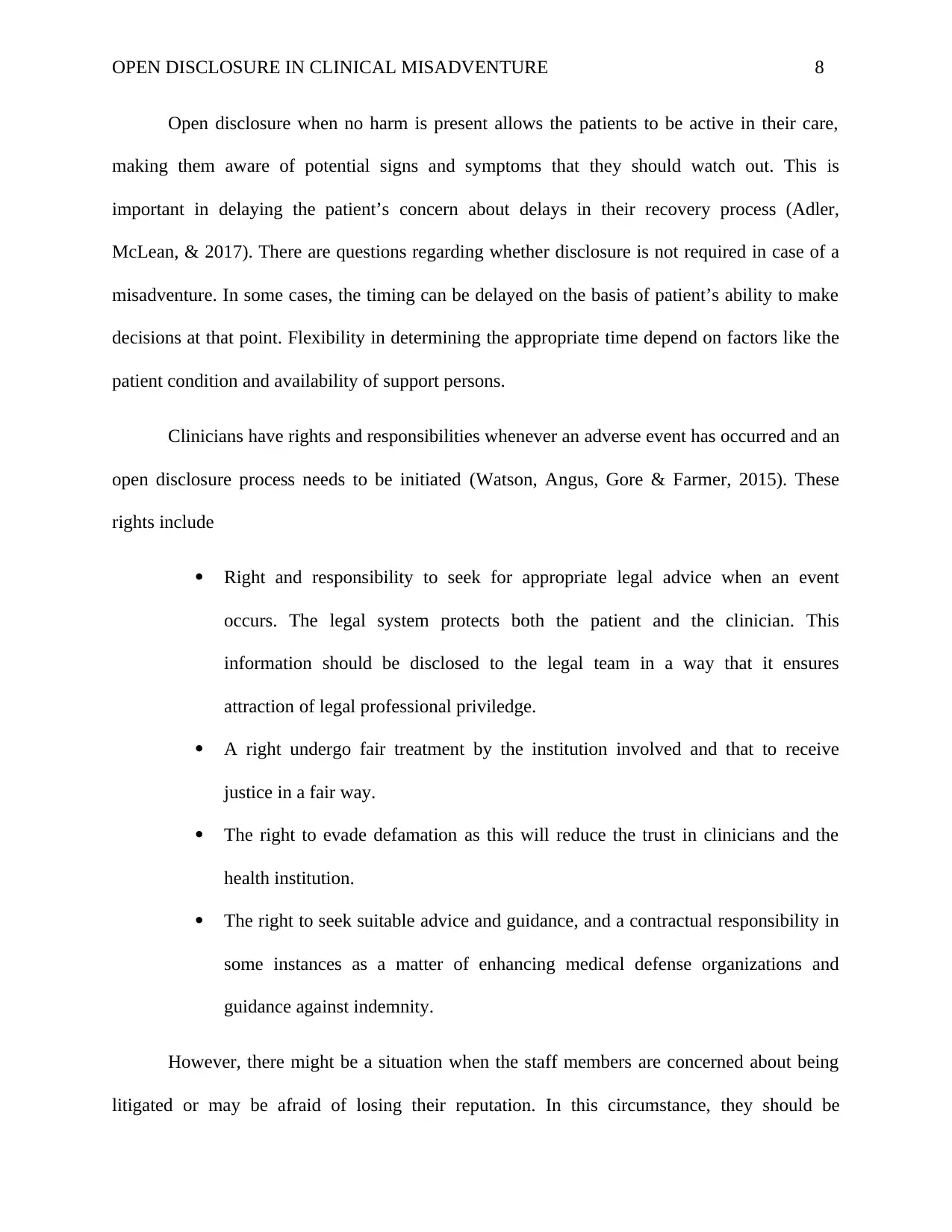
OPEN DISCLOSURE IN CLINICAL MISADVENTURE 8
Open disclosure when no harm is present allows the patients to be active in their care,
making them aware of potential signs and symptoms that they should watch out. This is
important in delaying the patient’s concern about delays in their recovery process (Adler,
McLean, & 2017). There are questions regarding whether disclosure is not required in case of a
misadventure. In some cases, the timing can be delayed on the basis of patient’s ability to make
decisions at that point. Flexibility in determining the appropriate time depend on factors like the
patient condition and availability of support persons.
Clinicians have rights and responsibilities whenever an adverse event has occurred and an
open disclosure process needs to be initiated (Watson, Angus, Gore & Farmer, 2015). These
rights include
Right and responsibility to seek for appropriate legal advice when an event
occurs. The legal system protects both the patient and the clinician. This
information should be disclosed to the legal team in a way that it ensures
attraction of legal professional priviledge.
A right undergo fair treatment by the institution involved and that to receive
justice in a fair way.
The right to evade defamation as this will reduce the trust in clinicians and the
health institution.
The right to seek suitable advice and guidance, and a contractual responsibility in
some instances as a matter of enhancing medical defense organizations and
guidance against indemnity.
However, there might be a situation when the staff members are concerned about being
litigated or may be afraid of losing their reputation. In this circumstance, they should be
Open disclosure when no harm is present allows the patients to be active in their care,
making them aware of potential signs and symptoms that they should watch out. This is
important in delaying the patient’s concern about delays in their recovery process (Adler,
McLean, & 2017). There are questions regarding whether disclosure is not required in case of a
misadventure. In some cases, the timing can be delayed on the basis of patient’s ability to make
decisions at that point. Flexibility in determining the appropriate time depend on factors like the
patient condition and availability of support persons.
Clinicians have rights and responsibilities whenever an adverse event has occurred and an
open disclosure process needs to be initiated (Watson, Angus, Gore & Farmer, 2015). These
rights include
Right and responsibility to seek for appropriate legal advice when an event
occurs. The legal system protects both the patient and the clinician. This
information should be disclosed to the legal team in a way that it ensures
attraction of legal professional priviledge.
A right undergo fair treatment by the institution involved and that to receive
justice in a fair way.
The right to evade defamation as this will reduce the trust in clinicians and the
health institution.
The right to seek suitable advice and guidance, and a contractual responsibility in
some instances as a matter of enhancing medical defense organizations and
guidance against indemnity.
However, there might be a situation when the staff members are concerned about being
litigated or may be afraid of losing their reputation. In this circumstance, they should be
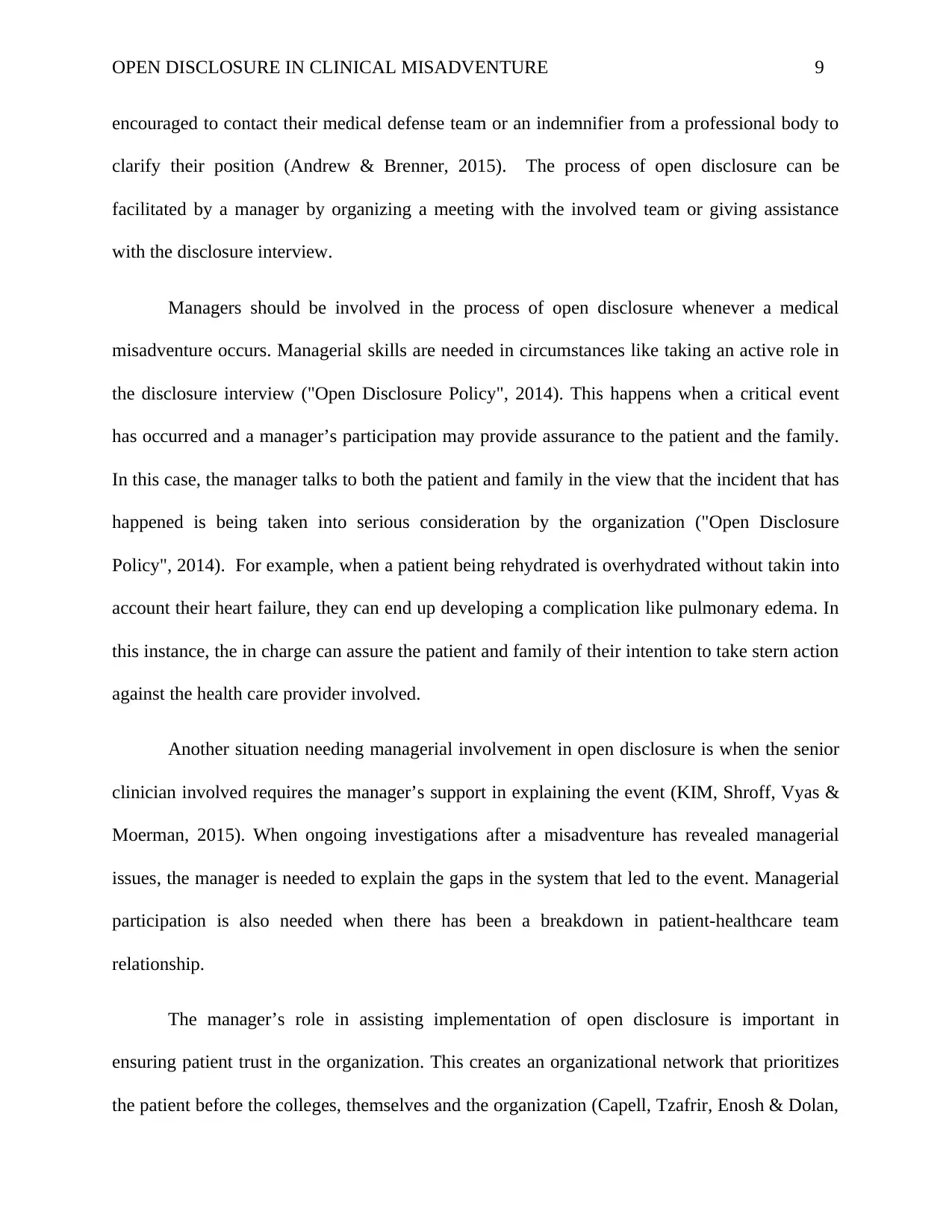
OPEN DISCLOSURE IN CLINICAL MISADVENTURE 9
encouraged to contact their medical defense team or an indemnifier from a professional body to
clarify their position (Andrew & Brenner, 2015). The process of open disclosure can be
facilitated by a manager by organizing a meeting with the involved team or giving assistance
with the disclosure interview.
Managers should be involved in the process of open disclosure whenever a medical
misadventure occurs. Managerial skills are needed in circumstances like taking an active role in
the disclosure interview ("Open Disclosure Policy", 2014). This happens when a critical event
has occurred and a manager’s participation may provide assurance to the patient and the family.
In this case, the manager talks to both the patient and family in the view that the incident that has
happened is being taken into serious consideration by the organization ("Open Disclosure
Policy", 2014). For example, when a patient being rehydrated is overhydrated without takin into
account their heart failure, they can end up developing a complication like pulmonary edema. In
this instance, the in charge can assure the patient and family of their intention to take stern action
against the health care provider involved.
Another situation needing managerial involvement in open disclosure is when the senior
clinician involved requires the manager’s support in explaining the event (KIM, Shroff, Vyas &
Moerman, 2015). When ongoing investigations after a misadventure has revealed managerial
issues, the manager is needed to explain the gaps in the system that led to the event. Managerial
participation is also needed when there has been a breakdown in patient-healthcare team
relationship.
The manager’s role in assisting implementation of open disclosure is important in
ensuring patient trust in the organization. This creates an organizational network that prioritizes
the patient before the colleges, themselves and the organization (Capell, Tzafrir, Enosh & Dolan,
encouraged to contact their medical defense team or an indemnifier from a professional body to
clarify their position (Andrew & Brenner, 2015). The process of open disclosure can be
facilitated by a manager by organizing a meeting with the involved team or giving assistance
with the disclosure interview.
Managers should be involved in the process of open disclosure whenever a medical
misadventure occurs. Managerial skills are needed in circumstances like taking an active role in
the disclosure interview ("Open Disclosure Policy", 2014). This happens when a critical event
has occurred and a manager’s participation may provide assurance to the patient and the family.
In this case, the manager talks to both the patient and family in the view that the incident that has
happened is being taken into serious consideration by the organization ("Open Disclosure
Policy", 2014). For example, when a patient being rehydrated is overhydrated without takin into
account their heart failure, they can end up developing a complication like pulmonary edema. In
this instance, the in charge can assure the patient and family of their intention to take stern action
against the health care provider involved.
Another situation needing managerial involvement in open disclosure is when the senior
clinician involved requires the manager’s support in explaining the event (KIM, Shroff, Vyas &
Moerman, 2015). When ongoing investigations after a misadventure has revealed managerial
issues, the manager is needed to explain the gaps in the system that led to the event. Managerial
participation is also needed when there has been a breakdown in patient-healthcare team
relationship.
The manager’s role in assisting implementation of open disclosure is important in
ensuring patient trust in the organization. This creates an organizational network that prioritizes
the patient before the colleges, themselves and the organization (Capell, Tzafrir, Enosh & Dolan,
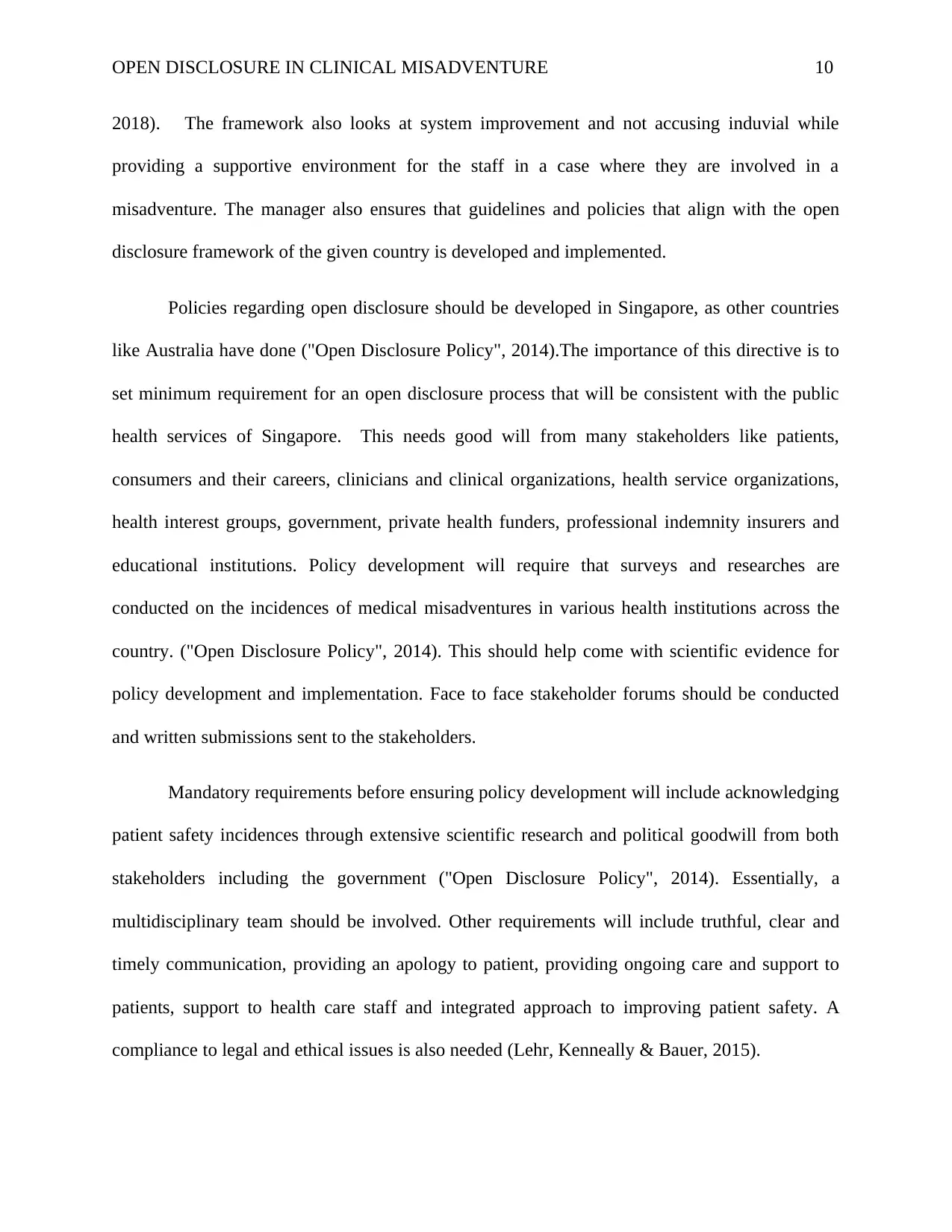
OPEN DISCLOSURE IN CLINICAL MISADVENTURE 10
2018). The framework also looks at system improvement and not accusing induvial while
providing a supportive environment for the staff in a case where they are involved in a
misadventure. The manager also ensures that guidelines and policies that align with the open
disclosure framework of the given country is developed and implemented.
Policies regarding open disclosure should be developed in Singapore, as other countries
like Australia have done ("Open Disclosure Policy", 2014).The importance of this directive is to
set minimum requirement for an open disclosure process that will be consistent with the public
health services of Singapore. This needs good will from many stakeholders like patients,
consumers and their careers, clinicians and clinical organizations, health service organizations,
health interest groups, government, private health funders, professional indemnity insurers and
educational institutions. Policy development will require that surveys and researches are
conducted on the incidences of medical misadventures in various health institutions across the
country. ("Open Disclosure Policy", 2014). This should help come with scientific evidence for
policy development and implementation. Face to face stakeholder forums should be conducted
and written submissions sent to the stakeholders.
Mandatory requirements before ensuring policy development will include acknowledging
patient safety incidences through extensive scientific research and political goodwill from both
stakeholders including the government ("Open Disclosure Policy", 2014). Essentially, a
multidisciplinary team should be involved. Other requirements will include truthful, clear and
timely communication, providing an apology to patient, providing ongoing care and support to
patients, support to health care staff and integrated approach to improving patient safety. A
compliance to legal and ethical issues is also needed (Lehr, Kenneally & Bauer, 2015).
2018). The framework also looks at system improvement and not accusing induvial while
providing a supportive environment for the staff in a case where they are involved in a
misadventure. The manager also ensures that guidelines and policies that align with the open
disclosure framework of the given country is developed and implemented.
Policies regarding open disclosure should be developed in Singapore, as other countries
like Australia have done ("Open Disclosure Policy", 2014).The importance of this directive is to
set minimum requirement for an open disclosure process that will be consistent with the public
health services of Singapore. This needs good will from many stakeholders like patients,
consumers and their careers, clinicians and clinical organizations, health service organizations,
health interest groups, government, private health funders, professional indemnity insurers and
educational institutions. Policy development will require that surveys and researches are
conducted on the incidences of medical misadventures in various health institutions across the
country. ("Open Disclosure Policy", 2014). This should help come with scientific evidence for
policy development and implementation. Face to face stakeholder forums should be conducted
and written submissions sent to the stakeholders.
Mandatory requirements before ensuring policy development will include acknowledging
patient safety incidences through extensive scientific research and political goodwill from both
stakeholders including the government ("Open Disclosure Policy", 2014). Essentially, a
multidisciplinary team should be involved. Other requirements will include truthful, clear and
timely communication, providing an apology to patient, providing ongoing care and support to
patients, support to health care staff and integrated approach to improving patient safety. A
compliance to legal and ethical issues is also needed (Lehr, Kenneally & Bauer, 2015).
Secure Best Marks with AI Grader
Need help grading? Try our AI Grader for instant feedback on your assignments.
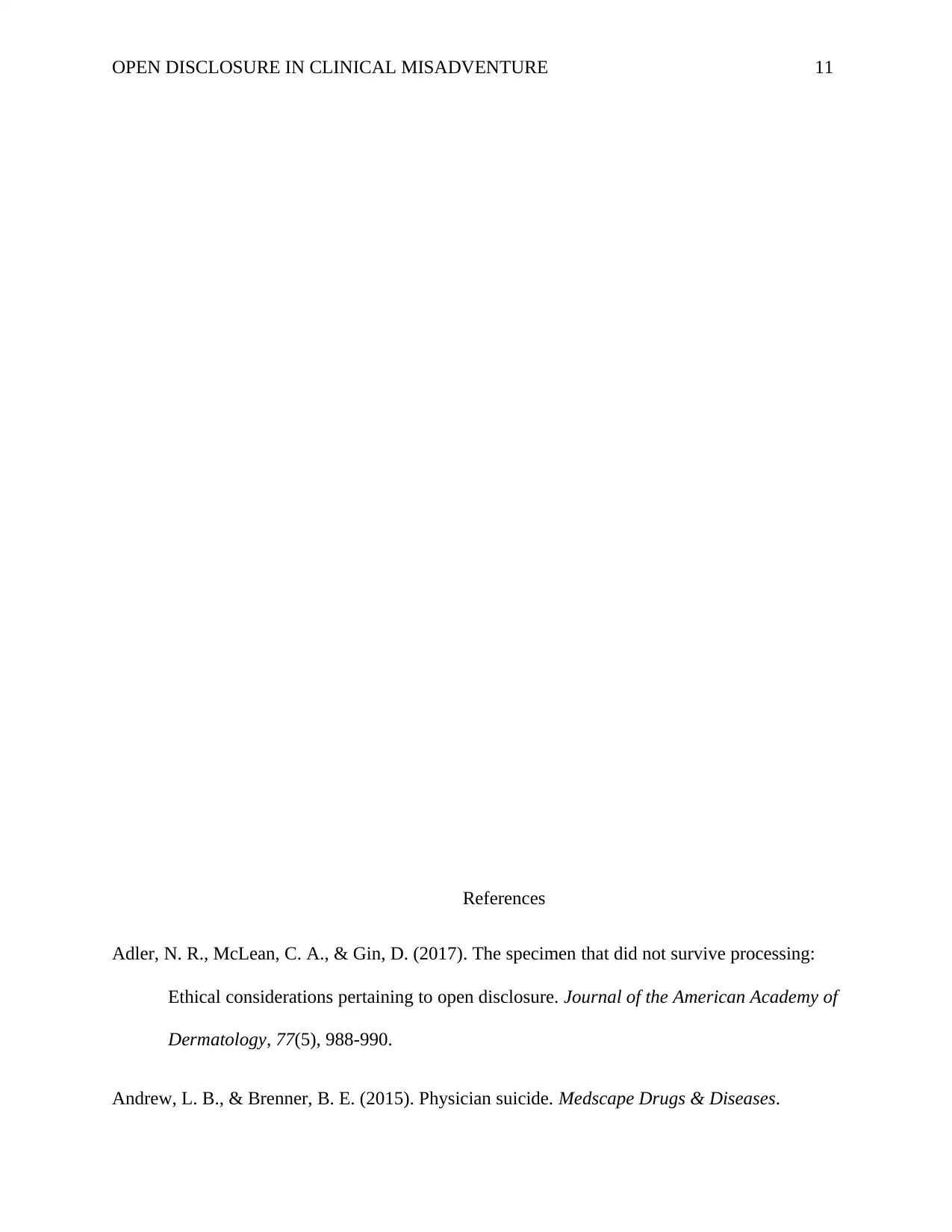
OPEN DISCLOSURE IN CLINICAL MISADVENTURE 11
References
Adler, N. R., McLean, C. A., & Gin, D. (2017). The specimen that did not survive processing:
Ethical considerations pertaining to open disclosure. Journal of the American Academy of
Dermatology, 77(5), 988-990.
Andrew, L. B., & Brenner, B. E. (2015). Physician suicide. Medscape Drugs & Diseases.
References
Adler, N. R., McLean, C. A., & Gin, D. (2017). The specimen that did not survive processing:
Ethical considerations pertaining to open disclosure. Journal of the American Academy of
Dermatology, 77(5), 988-990.
Andrew, L. B., & Brenner, B. E. (2015). Physician suicide. Medscape Drugs & Diseases.

OPEN DISCLOSURE IN CLINICAL MISADVENTURE 12
Capell, B., Tzafrir, S. S., Enosh, G., & Dolan, S. L. (2018). Explaining sexual minorities’
disclosure: The role of trust embedded in organizational practices. Organization Studies,
39(7), 947-973.
Fisch, J. E., Gelbach, J. B., & Klick, J. (2016). After Halliburton: Event studies and their role in
federal securities fraud litigation.
Jackson, E. (2016). Medical law: text, cases and materials (4th ed., pp. 40-135). Oxford, United
Kingdom: Oxford University Press.
KIM, J. B., Shroff, P. K., Vyas, D. U., & Moerman, R. W. (2015). Active CDS trading and
managers’ voluntary disclosure.
Koller, D., Rummens, A., Le Pouesard, M., Espin, S., Friedman, J., Coffey, M., & Kenneally, N.
(2016). Patient disclosure of medical errors in paediatrics: A systematic literature
review.Paediatrics & Child Health, 21(4), E32-E38. 10.1093/pch/21.4.e32
Leflar, R. (2011). The Law of Medical Misadventure in Japan (11th ed.). Japan: Chi-Kent-Lev.
Lehr, W., Kenneally, E., & Bauer, S. (2015). The Road to an Open Internet is Paved with
Pragmatic Disclosure & Transparency Policies.
Okuyama, A., Wagner, C., & Bijnen, B. (2014). Speaking up for patient safety by hospital-based
health care professionals: a literature review. BMC health services research, 14(1), 61.
Piper, D., Iedema, R., & Bower, K. (2014). Rural patients' experiences of the open disclosure of
adverse events. Australian journal of rural health, 22(4), 197-203.
Capell, B., Tzafrir, S. S., Enosh, G., & Dolan, S. L. (2018). Explaining sexual minorities’
disclosure: The role of trust embedded in organizational practices. Organization Studies,
39(7), 947-973.
Fisch, J. E., Gelbach, J. B., & Klick, J. (2016). After Halliburton: Event studies and their role in
federal securities fraud litigation.
Jackson, E. (2016). Medical law: text, cases and materials (4th ed., pp. 40-135). Oxford, United
Kingdom: Oxford University Press.
KIM, J. B., Shroff, P. K., Vyas, D. U., & Moerman, R. W. (2015). Active CDS trading and
managers’ voluntary disclosure.
Koller, D., Rummens, A., Le Pouesard, M., Espin, S., Friedman, J., Coffey, M., & Kenneally, N.
(2016). Patient disclosure of medical errors in paediatrics: A systematic literature
review.Paediatrics & Child Health, 21(4), E32-E38. 10.1093/pch/21.4.e32
Leflar, R. (2011). The Law of Medical Misadventure in Japan (11th ed.). Japan: Chi-Kent-Lev.
Lehr, W., Kenneally, E., & Bauer, S. (2015). The Road to an Open Internet is Paved with
Pragmatic Disclosure & Transparency Policies.
Okuyama, A., Wagner, C., & Bijnen, B. (2014). Speaking up for patient safety by hospital-based
health care professionals: a literature review. BMC health services research, 14(1), 61.
Piper, D., Iedema, R., & Bower, K. (2014). Rural patients' experiences of the open disclosure of
adverse events. Australian journal of rural health, 22(4), 197-203.
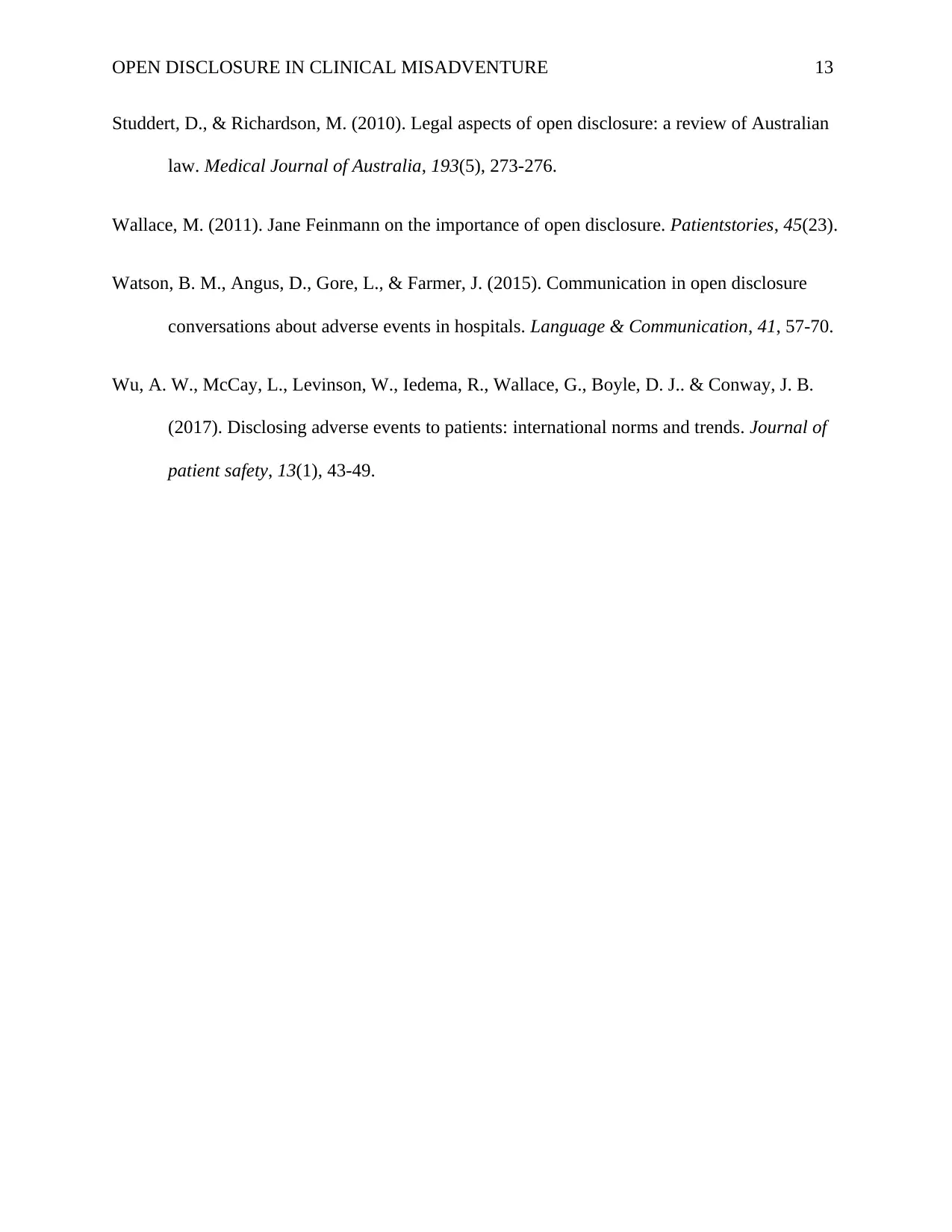
OPEN DISCLOSURE IN CLINICAL MISADVENTURE 13
Studdert, D., & Richardson, M. (2010). Legal aspects of open disclosure: a review of Australian
law. Medical Journal of Australia, 193(5), 273-276.
Wallace, M. (2011). Jane Feinmann on the importance of open disclosure. Patientstories, 45(23).
Watson, B. M., Angus, D., Gore, L., & Farmer, J. (2015). Communication in open disclosure
conversations about adverse events in hospitals. Language & Communication, 41, 57-70.
Wu, A. W., McCay, L., Levinson, W., Iedema, R., Wallace, G., Boyle, D. J.. & Conway, J. B.
(2017). Disclosing adverse events to patients: international norms and trends. Journal of
patient safety, 13(1), 43-49.
Studdert, D., & Richardson, M. (2010). Legal aspects of open disclosure: a review of Australian
law. Medical Journal of Australia, 193(5), 273-276.
Wallace, M. (2011). Jane Feinmann on the importance of open disclosure. Patientstories, 45(23).
Watson, B. M., Angus, D., Gore, L., & Farmer, J. (2015). Communication in open disclosure
conversations about adverse events in hospitals. Language & Communication, 41, 57-70.
Wu, A. W., McCay, L., Levinson, W., Iedema, R., Wallace, G., Boyle, D. J.. & Conway, J. B.
(2017). Disclosing adverse events to patients: international norms and trends. Journal of
patient safety, 13(1), 43-49.
1 out of 13
Related Documents
Your All-in-One AI-Powered Toolkit for Academic Success.
+13062052269
info@desklib.com
Available 24*7 on WhatsApp / Email
![[object Object]](/_next/static/media/star-bottom.7253800d.svg)
Unlock your academic potential
© 2024 | Zucol Services PVT LTD | All rights reserved.




